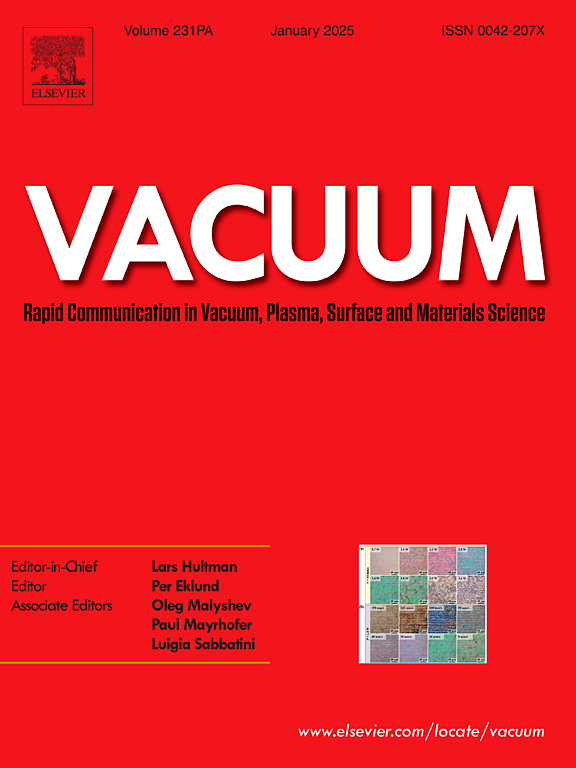通过孔型坩埚抑制SiC晶体边缘分解
IF 3.8
2区 材料科学
Q2 MATERIALS SCIENCE, MULTIDISCIPLINARY
引用次数: 0
摘要
碳化硅作为一种宽带隙半导体材料,具有广阔的应用前景。然而,目前的商业生产尺寸被限制在6英寸,并且随着尺寸的增长,生产更大的单晶的挑战呈指数增长。径向生长条件的恶化严重阻碍了大单晶的生长。本文提出了一种改进的坩埚结构,以改善晶体边缘退化,从而有利于晶体直径的扩大。通过观察晶体及晶边和坩埚盖处的结晶情况,应用经典成核理论计算了生长早期种子晶体边缘、石墨纸和导流环三个潜在成核位置的成核过程。结果表明,较高的过饱和比有利于石墨纸的成核,从而提示了晶体边缘分解形成的潜在机制。为了降低生长初期的过饱和率,提出了在坩埚盖上打孔的方法。三个开口和六个开口的方案进行了比较。结果表明:六开孔坩埚有效地降低了生长初期的过饱和比,使晶体无边缘分解;Raman和HRXRD-RC结果表明,该晶体具有较好的晶体结构均匀性和较高的结晶度。本文章由计算机程序翻译,如有差异,请以英文原文为准。
Suppressing SiC crystal edge decomposition through pore-type crucible
As a wide bandgap semiconductor material, silicon carbide (SiC) has promising prospects for application. However, the current commercial production size is limited to six inches, and the challenge of producing larger single crystals increases exponentially as the size grows. The growth of large single crystals is significantly hindered by deteriorating radial growth conditions. This paper proposed a modified crucible structure to improve crystal edge degradation, thereby facilitating the expansion of the crystal diameter. By observing the crystal and the crystallization at the crystal edge and crucible cover, classical nucleation theory was applied to calculate the nucleation process at three potential nucleation sites during the early growth stage: the seed crystal edge, the graphite paper, and the diversion ring. The results indicated that a higher supersaturation ratio facilitated nucleation at the graphite paper, thereby suggesting a potential mechanism for the formation of crystal edge decomposition. To reduce the supersaturation ratio during the early growth stage, a method involving making holes in the crucible cover was proposed. Comparative schemes were conducted with three openings and six openings. The results showed that the six openings crucible effectively reduces the supersaturation ratio during the early growth stage, resulting in the crystal without edge decomposition. Raman and HRXRD-RC results indicated that the crystal had better crystal structure uniformity and higher crystallinity.
求助全文
通过发布文献求助,成功后即可免费获取论文全文。
去求助
来源期刊

Vacuum
工程技术-材料科学:综合
CiteScore
6.80
自引率
17.50%
发文量
0
审稿时长
34 days
期刊介绍:
Vacuum is an international rapid publications journal with a focus on short communication. All papers are peer-reviewed, with the review process for short communication geared towards very fast turnaround times. The journal also published full research papers, thematic issues and selected papers from leading conferences.
A report in Vacuum should represent a major advance in an area that involves a controlled environment at pressures of one atmosphere or below.
The scope of the journal includes:
1. Vacuum; original developments in vacuum pumping and instrumentation, vacuum measurement, vacuum gas dynamics, gas-surface interactions, surface treatment for UHV applications and low outgassing, vacuum melting, sintering, and vacuum metrology. Technology and solutions for large-scale facilities (e.g., particle accelerators and fusion devices). New instrumentation ( e.g., detectors and electron microscopes).
2. Plasma science; advances in PVD, CVD, plasma-assisted CVD, ion sources, deposition processes and analysis.
3. Surface science; surface engineering, surface chemistry, surface analysis, crystal growth, ion-surface interactions and etching, nanometer-scale processing, surface modification.
4. Materials science; novel functional or structural materials. Metals, ceramics, and polymers. Experiments, simulations, and modelling for understanding structure-property relationships. Thin films and coatings. Nanostructures and ion implantation.
 求助内容:
求助内容: 应助结果提醒方式:
应助结果提醒方式:


